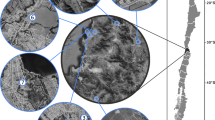Abstract
Goal, Scope and Background
The earthworm avoidance test is a sensitive screening test. Currently, two test designs, a two-chamber system and a six-chamber system, are under standardization. In the scope of the present study, the two test systems are compared. To assess the results, two procedures are applied, which are based on a threshold value and a statistical method. Moreover, the sensitivity of the avoidance test is compared with the sensitivity of the reproduction test.
Methods
The avoidance behaviour of E. fetida towards five chemicals (Cd, Cu, PCP, TBT, TNT) was tested in a sandy and a loamy soil. The ecotoxicological test was performed according to the draft guideline ISO/DIS 17512-1. The results were compared with the number of offspring determined in the reproduction test carried out according to ISO 11268-2.
Results and Discussion
The results demonstrate that the avoidance behaviour towards organic chemicals and heavy metals is a suitable screening method showing first tendencies of a chemical's effects on the habitat function of soils. Effects caused by chemical substances become visible at low concentrations and within short test periods. The sensitivity of the reproduction test and the avoidance test is principally comparable; in some cases, the avoidance test showed more sensitive reactions. The dose-response-relationships were more pronounced in the two-chamber test than in the six-chamber-system.
Recommendation and Outlook
The two-chamber-system proved to be more feasible than the six-chamber-system. As the sensitivity of the avoidance test and the reproduction test is comparable, the avoidance test can be considered as a suitable screening test as well. A possible field of application may be the selection of soil samples for which the reproduction assay seems necessary. To assess contaminated or remediated soils, the earthworm reproduction test is recommended as an indicator for the habitat function of the soils. To reduce costs, the labour intensive reproduction test could be largely replaced by the avoidance test in performing the earth-worm reproduction test only for relevant samples. Before the Draft International Standard of the guideline will be adopted as an ISO Guideline, there will be sufficient time left to gain further international experience required to finalize the method.
Similar content being viewed by others
Author information
Authors and Affiliations
Corresponding authors
Rights and permissions
About this article
Cite this article
Hund-Rinke, K., Lindemann, M. & Simon, M. Experiences with Novel Approaches in Earthworm Testing Alternatives (7 pp). J Soils Sediments 5, 233–239 (2005). https://doi.org/10.1065/jss2005.06.142
Received:
Accepted:
Published:
Issue Date:
DOI: https://doi.org/10.1065/jss2005.06.142




